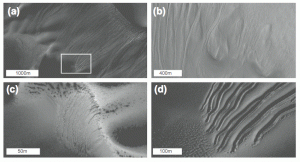The “megadune” in Russell Crater features linear grooves or gullies a few meters wide, a meter or two deep, and roughly a kilometer or two long.

RIDING ON AIR. According to a new hypothesis, blocks of CO2 ice carved linear gullies on dunes, sliding down shallow slopes on a cushion of sublimating gas. (Box in image (a) is shown at (d); images taken from Figure 1 in the paper.)
The origin of these gullies and similar ones in other high-latitude craters has been explained variously as flows of water-lubricated debris, liquid water, brines, and other agents. A new hypothesis, based on calculations, field experiments, and images from the HiRISE camera on NASA’s Mars Reconnaissance Orbiter, appears in Icarus from a team of scientists led by Serina Diniega (Jet Propulsion Laboratory).
“We present a new and detailed look at a dry hypothesis,” the team says. “Seasonal CO2 ice forms in the winter and breaks into blocks that fall down the dune slope, carving out a groove and leaving a terminal pit when the block comes to a rest and sublimates.”
The ice begins to form as fluffy CO2 frost as autumn temperatures fall. The frost then compacts into translucent ice during local winter. The ice forms in a way similar to the meter-thick slabs seen in the south polar regions and which give rise to the dark dusty “spiders” that appear in south polar spring. (North polar dunes also experience a similar icing effect from CO2 frosts.)
The linear gullies, however, form on dunes at lower latitudes where winters are not as severe. Thus the team estimates the slabs are probably thinner: a few tens of centimeters thick.
But dune slopes are shallow, only 7° to 12°. How can a block of ice slide down so gentle a slope? The answer, the scientists propose, is sublimation. Essentially, the ice block becomes lifted by gas sublimating from it and, riding on a cushion of Mars air, it slides easily down even shallow slopes. As the blocks slide, they erode the shallow grooves by pushing loose material forward and to the sides, forming levees, the team explains.
“I have always dreamed of going to Mars,” says Diniega. “Now I dream of snowboarding down a Martian sand dune on a block of dry ice.”








